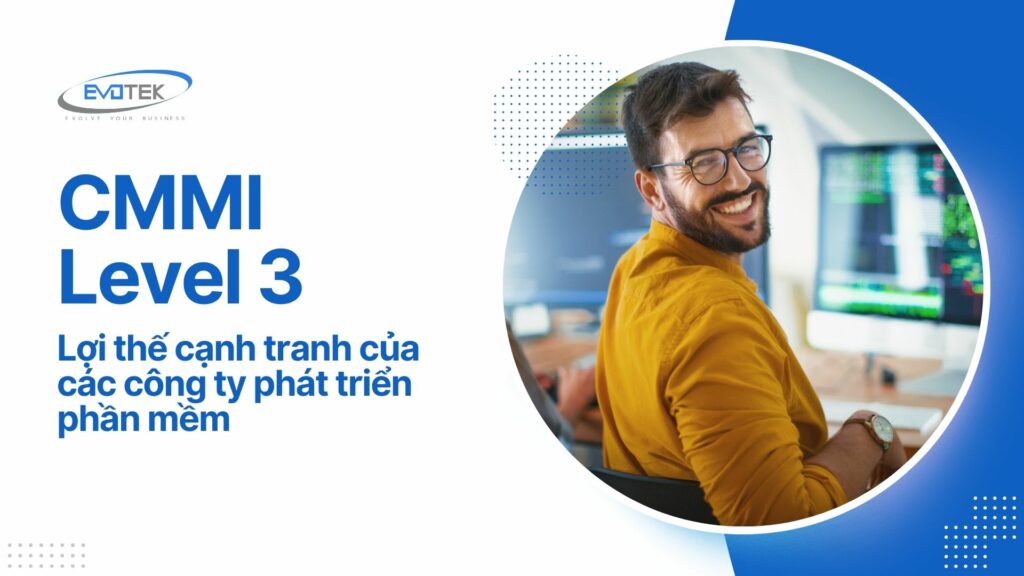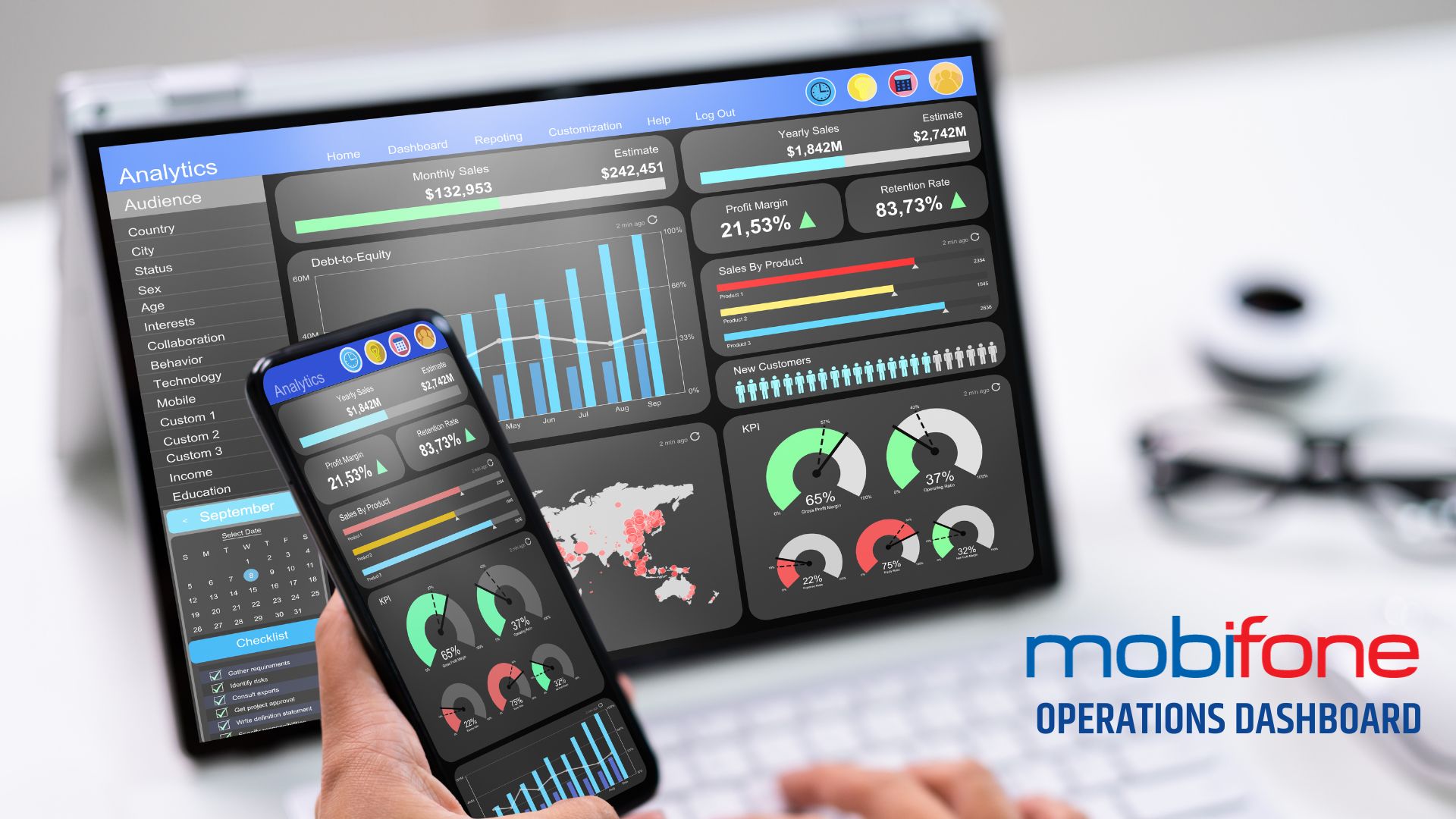The significant surge in demand for information technology compels businesses to seek reliable and high-quality IT service providers. In this context, CMMI Level 3 certification has emerged as a critical benchmark for assessing the reputation and capability of software companies.This certification is particularly indicative of a company’s proficiency in executing large-scale software projects owing to the high quality of its professional workflows.
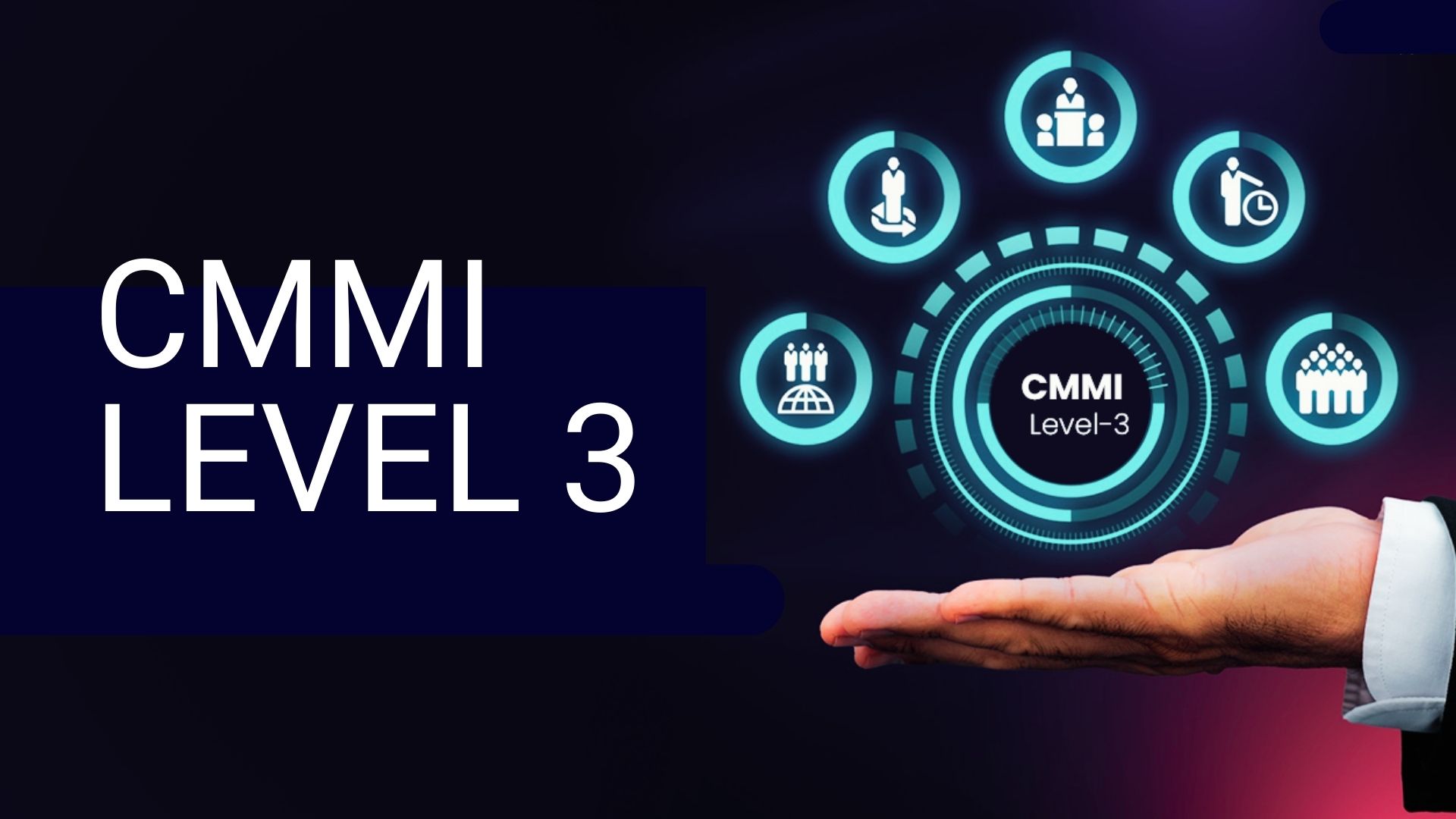
So what is CMMI Level 3 and why should businesses choose a partner with this certificate? Evotek ‘s following article will explain this issue in detail.
1. Introduction to CMMI
CMMI (Capability Maturity Model Integration) is a capability maturity model, developed by the US Software Engineering Institute (SEI) .
CMMI provides guidelines and criteria to evaluate the quality management capabilities and processes of software development organizations . Through CMMI, companies can improve management capacity, optimize processes and improve product quality.
CMMI is divided into 5 different maturity levels, including
- CMMI Level 1 – First step
- CMMI Level 2 – Managed Process
- CMMI Level 3 – Defined Processes
- CMMI Level 4 – Quantitatively managed processes
- CMMI Level 5 – Optimised Process
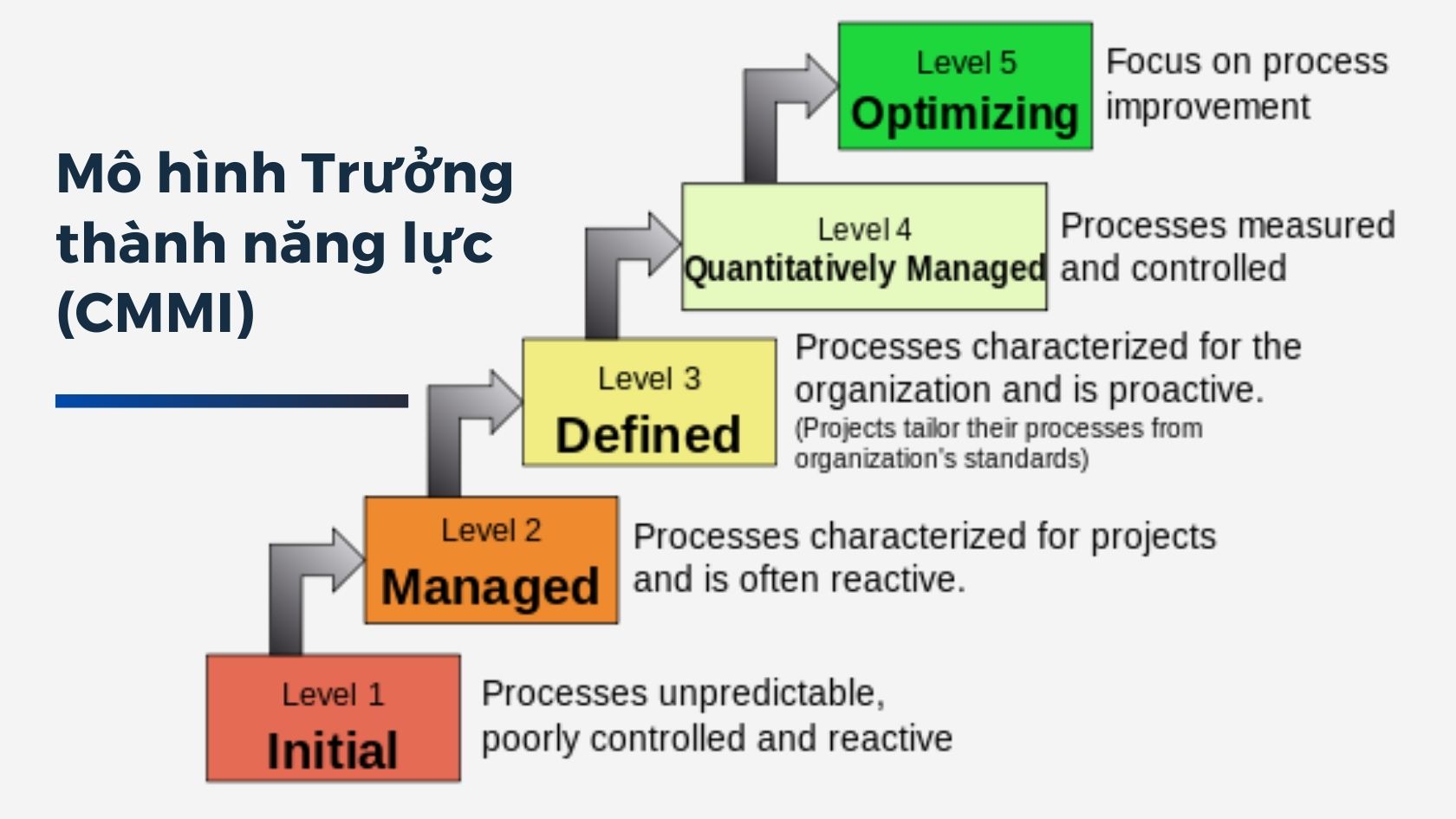
Each level represents different levels and capabilities of software businesses. Therefore, CMMI helps customers evaluate and select service providers.
2. What is CMMI Level 3?
CMMI Level 3, also known as “Defined Process” , shows that the software company has a standard and appropriate process system.
At this level, the company builds standard processes for each stage in the software development life cycle (SDLC). These standard processes are applied to all projects through effective project management.
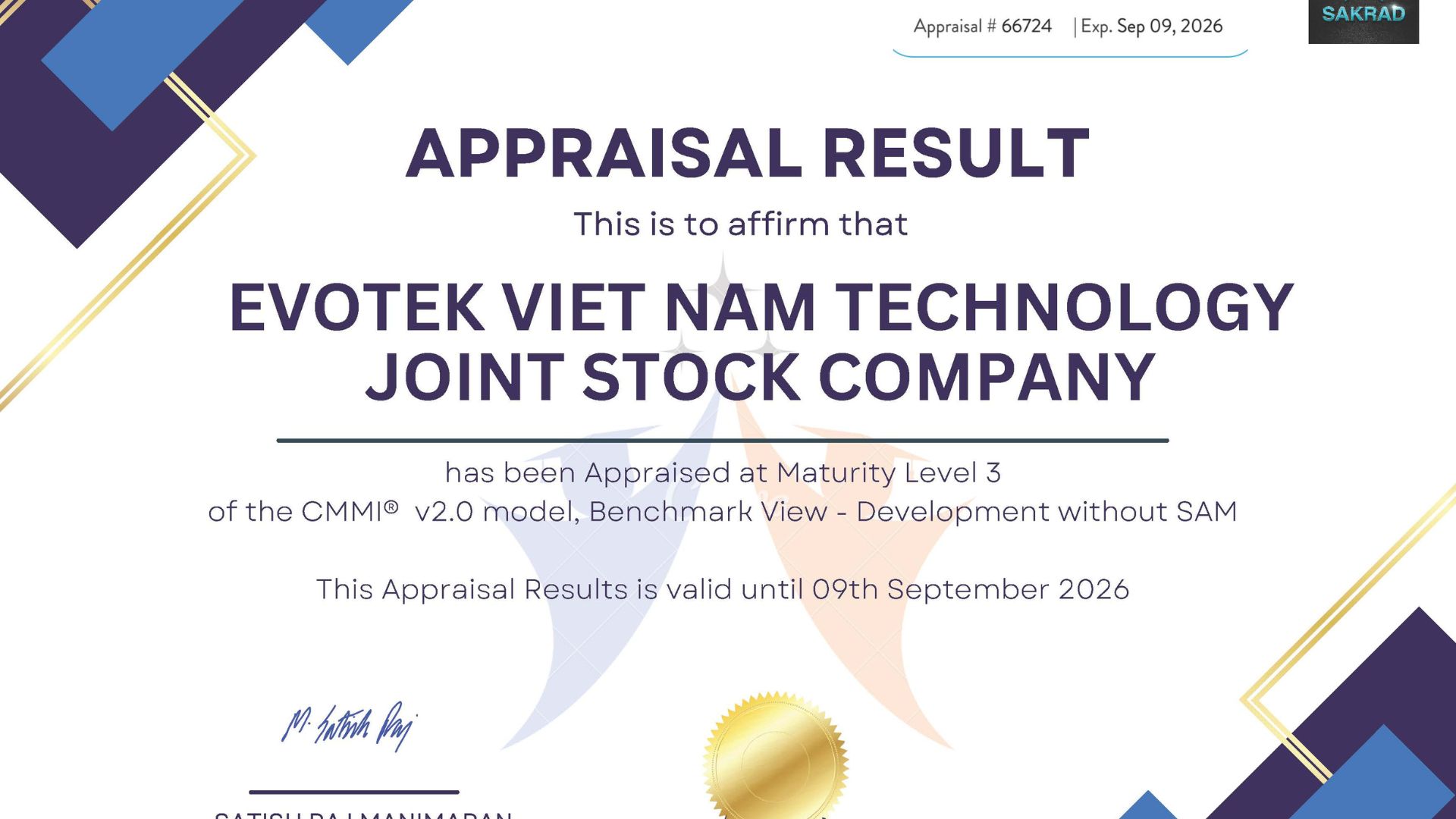
Strengths of CMMI Level 3:
- Clear standard process for every project
- Work quality and efficiency are more optimal
- Risks on cost, schedule, and quality are reduced
- Ensure customers are more satisfied with the product
Hence, holding CMMI Level 3 certification signifies that the software company possesses effective project management capabilities and adeptly fulfills customer requirements .
CMMI Achievement Criteria Across Each Level (Note: VERY Long table)
| 2 – Managed | Requirements Management | Manage Requirements | Obtain an Understanding of Requirements | 1 | 2 | 4 | 8 | 16 | 32 | 100% |
| Obtain Commitment to Requirements | 1 | 2 | 4 | 8 | 16 | 32 | 100% | |||
| Manage Requirements Changes | 1 | 2 | 4 | 8 | 16 | 32 | 100% | |||
| Maintain Bidirectional Traceability of Requirements | 1 | 2 | 4 | 8 | 16 | 32 | 100% | |||
| Identify Inconsistencies Between Project Work and Requirements | 1 | 2 | 4 | 8 | 16 | 32 | 100% | |||
| Project Planning | Establish Estimates | Estimate the Scope of the Project | 1 | 2 | 4 | 8 | 16 | 32 | 100% | |
| Establish Estimates of Work Product and Task Attributes | 1 | 2 | 4 | 8 | 16 | 32 | 100% | |||
| Define Project Life Cycle | 1 | 2 | 4 | 8 | 16 | 32 | 100% | |||
| Determine Estimates of Effort and Cost | 1 | 2 | 4 | 8 | 16 | 32 | 100% | |||
| Develop a Project Plan | Establish the Budget and Schedule | 1 | 2 | 4 | 8 | 16 | 32 | 100% | ||
| Identify Project Risks | 1 | 2 | 4 | 8 | 16 | 32 | 100% | |||
| Plan for Data Management | 1 | 2 | 4 | 8 | 16 | 32 | 100% | |||
| Plan for Project Resources | 1 | 2 | 4 | 8 | 16 | 32 | 100% | |||
| Plan for Needed Knowledge and Skills | 1 | 2 | 4 | 8 | 16 | 32 | 100% | |||
| Plan Stakeholder Involvement | 1 | 2 | 4 | 8 | 16 | 32 | 100% | |||
| Establish the Project Plan | 1 | 2 | 4 | 8 | 16 | 32 | 100% | |||
| Obtain Commitment to the Plan | Review Plans that Affect the Project | 1 | 2 | 4 | 8 | 16 | 32 | 100% | ||
| Reconcile Work and Resource Levels | 1 | 2 | 4 | 8 | 16 | 32 | 100% | |||
| Obtain Plan Commitment | 1 | 2 | 4 | 8 | 16 | 32 | 100% | |||
| Project Monitoring and Control | Monitor Project Against Plan | Monitor Project Planning Parameters | 1 | 2 | 4 | 8 | 16 | 32 | 100% | |
| Monitor Commitments | 1 | 2 | 4 | 8 | 16 | 32 | 100% | |||
| Monitor Project Risks | 1 | 2 | 4 | 8 | 16 | 32 | 100% | |||
| Monitor Data Management | 1 | 2 | 4 | 8 | 16 | 32 | 100% | |||
| Monitor Stakeholder Involvement | 1 | 2 | 4 | 8 | 16 | 32 | 100% | |||
| Conduct Progress Reviews | 1 | 2 | 4 | 8 | 16 | 32 | 100% | |||
| Conduct Milestone Reviews | 1 | 2 | 4 | 8 | 16 | 32 | 100% | |||
| Manage Corrective Action to Closure | Analyze Issues | 1 | 2 | 4 | 8 | 16 | 32 | 100% | ||
| Take Correction Action | 1 | 2 | 4 | 8 | 16 | 32 | 100% | |||
| Manage Corrective Action | 1 | 2 | 4 | 8 | 16 | 32 | 100% | |||
| Supplier Agreement Management | Establish Supplier Agreements | Determine Acquisition Type | 1 | 2 | 4 | 8 | 16 | 32 | 100% | |
| Select Suppliers | 1 | 2 | 4 | 8 | 16 | 32 | 100% | |||
| Establish Supplier Agreements | 1 | 2 | 4 | 8 | 16 | 32 | 100% | |||
| Satisfy Supplier Agreements | Review COTS Products | 1 | 2 | 4 | 8 | 16 | 32 | 100% | ||
| Execute the Supplier Agreement | 1 | 2 | 4 | 8 | 16 | 32 | 100% | |||
| Accept the Acquired Product | 1 | 2 | 4 | 8 | 16 | 32 | 100% | |||
| Transition Products | 1 | 2 | 4 | 8 | 16 | 32 | 100% | |||
| Measurement and Analysis | Align Measurement and Analysis Activities | Establish Measurement Objectives | 1 | 2 | 4 | 8 | 16 | 32 | 100% | |
| Specify Measures | 1 | 2 | 4 | 8 | 16 | 32 | 100% | |||
| Specify Data Collection and Storage Procedures | 1 | 2 | 4 | 8 | 16 | 32 | 100% | |||
| Specify Analysis Procedures | 1 | 2 | 4 | 8 | 16 | 32 | 100% | |||
| Provide Measurement Results | Collect Measurement Data | 1 | 2 | 4 | 8 | 16 | 32 | 100% | ||
| Analyze Measurement Data | 1 | 2 | 4 | 8 | 16 | 32 | 100% | |||
| Store Data and Results | 1 | 2 | 4 | 8 | 16 | 32 | 100% | |||
| Communicate Results | 1 | 2 | 4 | 8 | 16 | 32 | 100% | |||
| Process and Product Quality Assurance | Objectively Evaluate Processes | Objectively Evaluate Processes | 1 | 2 | 4 | 8 | 16 | 32 | 100% | |
| Objectively Evaluate Work Products and Services | 1 | 2 | 4 | 8 | 16 | 32 | 100% | |||
| Provide Objective Insight | Communicate and Ensure Resolution of Noncompliance Issues | 1 | 2 | 4 | 8 | 16 | 32 | 100% | ||
| Establish Records | 1 | 2 | 4 | 8 | 16 | 32 | 100% | |||
| Configuration Management | Establish Baselines | Identify Configuration Items | 1 | 2 | 4 | 8 | 16 | 32 | 100% | |
| Establish a Configuration Management System | 1 | 2 | 4 | 8 | 16 | 32 | 100% | |||
| Create or Release Baselines | 1 | 2 | 4 | 8 | 16 | 32 | 100% | |||
| Track and Control Changes | Track Change Requests | 1 | 2 | 4 | 8 | 16 | 32 | 100% | ||
| Control Configuration Items | 1 | 2 | 4 | 8 | 16 | 32 | 100% | |||
| Establish Integrity | Establish Configuration Management Records | 1 | 2 | 4 | 8 | 16 | 32 | 100% | ||
| Perform Configuration Audits | 1 | 2 | 4 | 8 | 16 | 32 | 100% | |||
| CMMI Level 2 Score | 100% | 100% | 100% | 100% | 100% | 100% | 100% | |||
| 3 – Defined | Requirements Development | Develop Customer Requirements | Collect Stakeholder Needs | 1 | 2 | 4 | 8 | 16 | 32 | 100% |
| Elicit Needs | 1 | 2 | 4 | 8 | 16 | 32 | 100% | |||
| Develop the Customer Requirements | 1 | 2 | 4 | 8 | 16 | 32 | 100% | |||
| Develop Product Requirements | Establish Product and Product-Component Requirements | 1 | 2 | 4 | 8 | 16 | 32 | 100% | ||
| Allocate Product Component Requirements | 1 | 2 | 4 | 8 | 16 | 32 | 100% | |||
| Identify Interface Requirements | 1 | 2 | 4 | 8 | 16 | 32 | 100% | |||
| Analyze and Validate Requirements | Establish Operational Concepts and Scenarios | 1 | 2 | 4 | 8 | 16 | 32 | 100% | ||
| Establish a Definition of Required Functionality | 1 | 2 | 4 | 8 | 16 | 32 | 100% | |||
| Analyze Requirements | 1 | 2 | 4 | 8 | 16 | 32 | 100% | |||
| Analyze Requirements to Achieve Balance | 1 | 2 | 4 | 8 | 16 | 32 | 100% | |||
| Validate Requirements | 1 | 2 | 4 | 8 | 16 | 32 | 100% | |||
| Validate Requirements with Comprehensive Methods | 1 | 2 | 4 | 8 | 16 | 32 | 100% | |||
| Technical Solution | Select Product- Component Solutions | Develop Alternative Solutions and Selection Criteria | 1 | 2 | 4 | 8 | 16 | 32 | 100% | |
| Develop Detailed Alternative Solutions and Selection Criteria | 1 | 2 | 4 | 8 | 16 | 32 | 100% | |||
| Evolve Operational Concepts and Scenarios | 1 | 2 | 4 | 8 | 16 | 32 | 100% | |||
| Select Product-Component Solutions | 1 | 2 | 4 | 8 | 16 | 32 | 100% | |||
| Develop the Design | Design the Product or Product Component | 1 | 2 | 4 | 8 | 16 | 32 | 100% | ||
| Establish a Technical Data Package | 1 | 2 | 4 | 8 | 16 | 32 | 100% | |||
| Establish Interface Descriptions | 1 | 2 | 4 | 8 | 16 | 32 | 100% | |||
| Design Interfaces Using Criteria | 1 | 2 | 4 | 8 | 16 | 32 | 100% | |||
| Perform Make, Buy, or Reuse Analyses | 1 | 2 | 4 | 8 | 16 | 32 | 100% | |||
| Implement the Product Design | Implement the Design | 1 | 2 | 4 | 8 | 16 | 32 | 100% | ||
| Develop Product Support Documentation | 1 | 2 | 4 | 8 | 16 | 32 | 100% | |||
| Product Integration | Prepare for Product Integration | Determine Integration Sequence | 1 | 2 | 4 | 8 | 16 | 32 | 100% | |
| Establish the Product Integration Environment | 1 | 2 | 4 | 8 | 16 | 32 | 100% | |||
| Establish Product Integration Procedures and Criteria | 1 | 2 | 4 | 8 | 16 | 32 | 100% | |||
| Ensure Interface Compatibility | Review Interface Descriptions for Completeness | 1 | 2 | 4 | 8 | 16 | 32 | 100% | ||
| Manage Interfaces | 1 | 2 | 4 | 8 | 16 | 32 | 100% | |||
| Assemble Product Components and Deliver the Product | Confirm Readiness of Product Components for Integration | 1 | 2 | 4 | 8 | 16 | 32 | 100% | ||
| Assemble Product Components | 1 | 2 | 4 | 8 | 16 | 32 | 100% | |||
| Evaluate Assembled Product Components | 1 | 2 | 4 | 8 | 16 | 32 | 100% | |||
| Package and Deliver the Product or Product Component | 1 | 2 | 4 | 8 | 16 | 32 | 100% | |||
| Verification | Prepare for Verification | Select Work Products for Verification | 1 | 2 | 4 | 8 | 16 | 32 | 100% | |
| Establish the Verification Environment | 1 | 2 | 4 | 8 | 16 | 32 | 100% | |||
| Establish Verification Procedures and Criteria | 1 | 2 | 4 | 8 | 16 | 32 | 100% | |||
| Perform Peer Reviews | Prepare for Peer Reviews | 1 | 2 | 4 | 8 | 16 | 32 | 100% | ||
| Conduct Peer Reviews | 1 | 2 | 4 | 8 | 16 | 32 | 100% | |||
| Analyze Peer Review Data | 1 | 2 | 4 | 8 | 16 | 32 | 100% | |||
| Verify Selected Work Products | Perform Verification | 1 | 2 | 4 | 8 | 16 | 32 | 100% | ||
| Analyze Verification Results and Identify Corrective Action | 1 | 2 | 4 | 8 | 16 | 32 | 100% | |||
| Prepare for Validatio | Select Products for Validation | 1 | 2 | 4 | 8 | 16 | 32 | 100% | ||
| Establish the Validation Environment | 1 | 2 | 4 | 8 | 16 | 32 | 100% | |||
| Validation | Establish Validation Procedures and Criteria | 1 | 2 | 4 | 8 | 16 | 32 | 100% | ||
| Validate Product or Product | Perform Validation | 1 | 2 | 4 | 8 | 16 | 32 | 100% | ||
| Analyze Validation Results | 1 | 2 | 4 | 8 | 16 | 32 | 100% | |||
| Organizational Process Focus | Determine Process- Improvement Opportunities | Establish Organizational Process Needs | 1 | 2 | 4 | 8 | 16 | 32 | 100% | |
| Appraise the Organization’s Processes | 1 | 2 | 4 | 8 | 16 | 32 | 100% | |||
| Identify the Organization’s Process Improvements | 1 | 2 | 4 | 8 | 16 | 32 | 100% | |||
| Plan and Implement Process- Improvement Activities | Establish Process Action Plans | 1 | 2 | 4 | 8 | 16 | 32 | 100% | ||
| Implement Process Action Plans | 1 | 2 | 4 | 8 | 16 | 32 | 100% | |||
| Deploy Organizational Process Assets | 1 | 2 | 4 | 8 | 16 | 32 | 100% | |||
| Incorporate Process-Related Experiences into the Organizational Proce | 1 | 2 | 4 | 8 | 16 | 32 | 100% | |||
| Organizational Process Definition | Establish Organizational Process Assets | Establish Standard Processes | 1 | 2 | 4 | 8 | 16 | 32 | 100% | |
| Establish Life-Cycle Model Descriptions | 1 | 2 | 4 | 8 | 16 | 32 | 100% | |||
| Establish Tailoring Criteria and Guidelines | 1 | 2 | 4 | 8 | 16 | 32 | 100% | |||
| Establish the Organization’s Measurement Repository | 1 | 2 | 4 | 8 | 16 | 32 | 100% | |||
| Establish the Organization’s Process Asset Library | 1 | 2 | 4 | 8 | 16 | 32 | 100% | |||
| Organizational Training | Establish an Organizational Training Capability | Establish the Strategic Training Needs | 1 | 2 | 4 | 8 | 16 | 32 | 100% | |
| Determine Which Training Needs Are the Responsibility of Organizati | 1 | 2 | 4 | 8 | 16 | 32 | 100% | |||
| Establish an Organizational Training Tactical Plan | 1 | 2 | 4 | 8 | 16 | 32 | 100% | |||
| Establish Training Capability | 1 | 2 | 4 | 8 | 16 | 32 | 100% | |||
| Provide Necessary Training | Deliver Training | 1 | 2 | 4 | 8 | 16 | 32 | 100% | ||
| Establish Training Records | 1 | 2 | 4 | 8 | 16 | 32 | 100% | |||
| Assess Training Effectiveness | 1 | 2 | 4 | 8 | 16 | 32 | 100% | |||
| Integrated Project Management for IPPD | Use the Project’s Defined Process | Establish the Project’s Defined Process | 1 | 2 | 4 | 8 | 16 | 32 | 100% | |
| Use Organizational Process Assets for Planning Project Activities | 1 | 2 | 4 | 8 | 16 | 32 | 100% | |||
| Integrate Plans | 1 | 2 | 4 | 8 | 16 | 32 | 100% | |||
| Manage the Project Using the Integrated Plans | 1 | 2 | 4 | 8 | 16 | 32 | 100% | |||
| Contribute to the Organizational Process Assets | 1 | 2 | 4 | 8 | 16 | 32 | 100% | |||
| Coordinate and Collaborate with Relevant | Manage Stakeholder Involvement | 1 | 2 | 4 | 8 | 16 | 32 | 100% | ||
| Manage Dependencies | 1 | 2 | 4 | 8 | 16 | 32 | 100% | |||
| Resolve Coordination Issues | 1 | 2 | 4 | 8 | 16 | 32 | 100% | |||
| Use the Project’s Shared Vision for | Define Project’s Shared-Vision Context | 1 | 2 | 4 | 8 | 16 | 32 | 100% | ||
| Establish the Project’s Shared Vision | 1 | 2 | 4 | 8 | 16 | 32 | 100% | |||
| Organize Integrated Teams for IPPD | Determine Integrated Team Structure for the Project | 1 | 2 | 4 | 8 | 16 | 32 | 100% | ||
| Develop Preliminary Distribution of Requirements to Integrated Teams | 1 | 2 | 4 | 8 | 16 | 32 | 100% | |||
| Establish Integrated Teams | 1 | 2 | 4 | 8 | 16 | 32 | 100% | |||
| Risk Management | Prepare for Risk Management | Determine Risk Sources and Categories | 1 | 2 | 4 | 8 | 16 | 32 | 100% | |
| Define Risk Parameters | 1 | 2 | 4 | 8 | 16 | 32 | 100% | |||
| Establish a Risk Management Strategy | 1 | 2 | 4 | 8 | 16 | 32 | 100% | |||
| Identify and Analyze Risks | Identify Risks | 1 | 2 | 4 | 8 | 16 | 32 | 100% | ||
| Evaluate, Categorize, and Prioritize Risks | 1 | 2 | 4 | 8 | 16 | 32 | 100% | |||
| Mitigate Risks | Develop Risk Mitigation Plans | 1 | 2 | 4 | 8 | 16 | 32 | 100% | ||
| Implement Risk Mitigation Plans | 1 | 2 | 4 | 8 | 16 | 32 | 100% | |||
| Integrated Teaming | Establish Team Composition | Identify Team Tasks | 1 | 2 | 4 | 8 | 16 | 32 | 100% | |
| Identify Needed Knowledge and Skills | 1 | 2 | 4 | 8 | 16 | 32 | 100% | |||
| Assign Appropriate Team Members | 1 | 2 | 4 | 8 | 16 | 32 | 100% | |||
| Govern Team Operation | Establish a Shared Vision | 1 | 2 | 4 | 8 | 16 | 32 | 100% | ||
| Establish a Team Charter | 1 | 2 | 4 | 8 | 16 | 32 | 100% | |||
| Define Roles and Responsibilities | 1 | 2 | 4 | 8 | 16 | 32 | 100% | |||
| Establish Operating Procedures | 1 | 2 | 4 | 8 | 16 | 32 | 100% | |||
| Collaborate Among Interfacing Teams | 1 | 2 | 4 | 8 | 16 | 32 | 100% | |||
| Integrated Supplier Management | Analyze and Select Sources of Products | Analyze Potential Sources of Products | 1 | 2 | 4 | 8 | 16 | 32 | 100% | |
| Evaluate and Determine Sources of Products | 1 | 2 | 4 | 8 | 16 | 32 | 100% | |||
| Coordinate Work with Suppliers | Monitor Selected Supplier Work Products | 1 | 2 | 4 | 8 | 16 | 32 | 100% | ||
| Evaluate Selected Supplier Work Products | 1 | 2 | 4 | 8 | 16 | 32 | 100% | |||
| Revise the Supplier Agreement or Relationship | 1 | 2 | 4 | 8 | 16 | 32 | 100% | |||
| Decision Analysis and Resolution | Evaluate Alternatives | Establish Guidelines for Decision Analysis | 1 | 2 | 4 | 8 | 16 | 32 | 100% | |
| Establish Evaluation Criteria | 1 | 2 | 4 | 8 | 16 | 32 | 100% | |||
| Identify Alternative Solutions | 1 | 2 | 4 | 8 | 16 | 32 | 100% | |||
| Select Evaluation Methods | 1 | 2 | 4 | 8 | 16 | 32 | 100% | |||
| Evaluate Alternatives | 1 | 2 | 4 | 8 | 16 | 32 | 100% | |||
| Select Solutions | 1 | 2 | 4 | 8 | 16 | 32 | 100% | |||
| Organizational Environment for Integration | Provide IPPD Infrastructure | Establish the Organization’s Shared Vision | 1 | 2 | 4 | 8 | 16 | 32 | 100% | |
| Establish an Integrated Work Environment | 1 | 2 | 4 | 8 | 16 | 32 | 100% | |||
| Identify IPPD-Unique Skill Requirements | 1 | 2 | 4 | 8 | 16 | 32 | 100% | |||
| Manage People for Integration | Establish Leadership Mechanisms | 1 | 2 | 4 | 8 | 16 | 32 | 100% | ||
| Establish Incentives for Integration | 1 | 2 | 4 | 8 | 16 | 32 | 100% | |||
| Establish Mechanisms to Balance Team and Home Organization Resp | 1 | 2 | 4 | 8 | 16 | 32 | 100% | |||
| CMMI Level 3 Score | 100% | 100% | 100% | 100% | 100% | 100% | 100% | |||
| 4 – Quantitatively Managed | Organizational Process Performance | Establish Performance Baselines and Models | Select Processes | 1 | 2 | 4 | 8 | 16 | 32 | 100% |
| Establish Process Performance Measures | 1 | 2 | 4 | 8 | 16 | 32 | 100% | |||
| Establish Quality and Process-Performance Objectives | 1 | 2 | 4 | 8 | 16 | 32 | 100% | |||
| Establish Process Performance Baselines | 1 | 2 | 4 | 8 | 16 | 32 | 100% | |||
| Establish Process Performance Models | 1 | 2 | 4 | 8 | 16 | 32 | 100% | |||
| Quantitative Project Management | Quantitatively Manage the Project | Establish the Project’s Objectives | 1 | 2 | 4 | 8 | 16 | 32 | 100% | |
| Compose the Defined Process | 1 | 2 | 4 | 8 | 16 | 32 | 100% | |||
| Select the Subprocesses that Will Be Statistically Managed | 1 | 2 | 4 | 8 | 16 | 32 | 100% | |||
| Manage Project Performance | 1 | 2 | 4 | 8 | 16 | 32 | 100% | |||
| Statistically Manage Subprocess Performance | Select Measures and Analytic Techniques | 1 | 2 | 4 | 8 | 16 | 32 | 100% | ||
| Apply Statistical Methods to Understand Variation | 1 | 2 | 4 | 8 | 16 | 32 | 100% | |||
| Monitor Performance of the Selected Subprocesses | 1 | 2 | 4 | 8 | 16 | 32 | 100% | |||
| Record Statistical Management Data | 1 | 2 | 4 | 8 | 16 | 32 | 100% | |||
| CMMI Level 4 Score | 100% | 100% | 100% | 100% | 100% | 100% | 100% | |||
| 5 – Optimizing | Organizational Innovation and Deployment | Select Improvements | Collect and Analyze Improvement Proposals | 1 | 2 | 4 | 8 | 16 | 32 | 100% |
| Identify and Analyze Innovations | 1 | 2 | 4 | 8 | 16 | 32 | 100% | |||
| Pilot Improvements | 1 | 2 | 4 | 8 | 16 | 32 | 100% | |||
| Select Improvements for Deployment | 1 | 2 | 4 | 8 | 16 | 32 | 100% | |||
| Deploy Improvements | Plan the Deployment | 1 | 2 | 4 | 8 | 16 | 32 | 100% | ||
| Manage the Deployment | 1 | 2 | 4 | 8 | 16 | 32 | 100% | |||
| Measure Improvement Effects | 1 | 2 | 4 | 8 | 16 | 32 | 100% | |||
| Causal Analysis and Resolution | Determine Causes of Defects | Select Defect Data for Analysis | 1 | 2 | 4 | 8 | 16 | 32 | 100% | |
| Analyze Causes | 1 | 2 | 4 | 8 | 16 | 32 | 100% | |||
| Address Causes of Defects | Implement the Action Proposals | 1 | 2 | 4 | 8 | 16 | 32 | 100% | ||
| Evaluate the Effect of Changes | 1 | 2 | 4 | 8 | 16 | 32 | 100% | |||
| Record Data | 1 | 2 | 4 | 8 | 16 | 32 | 100% | |||
| CMMI Level 5 Score | 100% | 100% | 100% | 100% | 100% | 100% | 100% | |||
3. Benefits of choosing a partner with CMMI Level 3
There are many benefits when businesses choose a partner providing software/IT services with CMMI Level 3 certification, specifically:
| Benefit | Description | Benefited Industries |
| Product quality is guaranteed | Companies that achieve CMMI level 3 have better quality control capabilities. Software is developed according to requirements, with fewer errors and problems. | Manufacturing, Healthcare, Energy and Utilities |
| Project cost savings | Strict processes and project management capabilities help minimize costs and schedule risks. Customers do not have to face additional costs or extended completion time. | Government, Transportation and Logistics, Manufacturing |
| Reliability and low risk | The reliability and reputation of CMMI level 3 suppliers are higher. This is an important factor to consider when choosing a long-term partner. | Banking and Finance, Healthcare, Government |
| Less information security risk | The standard process of CMMI level 3 includes information security requirements according to international standards. Especially important for projects involving sensitive data. Banking and Finance, Healthcare, Government | Banking and Finance, Healthcare, Government |
| Better post-deployment support | CMMI Level 3 companies typically have better support capabilities once the product goes live. | Retail, Transportation and Logistics, Energy and Utilities |
| Cơ hội mở rộng thị trường | Đối với các công ty phần mềm muốn mở rộng thị trường, CMMI cấp độ 3 là chứng chỉ cần thiết để thuyết phục khách hàng ở các thị trường khó tính. | Truyền thông và Giải trí, Giáo dục, Sản xuất |
4. Các bước để đạt được chứng chỉ CMMI Level 3
| Step | Name | Description |
| 1 | Identify goals and benefits | Determine the reasons, goals and expected benefits when applying CMMI |
| 2 | Establish a project team | Establish a team with business and technical understanding of the company |
| 3 | Project team training | Train the team to understand CMMI and how to apply it |
| 4 | Initial evaluation | Evaluate current state of operations against CMMI, identify areas for improvement |
| 5 | Plan for application | Make detailed plans, assign responsibilities, and implementation roadmap |
| 6 | Implement improvements | Implement process improvement projects |
| 7 | Test and improve | Monitor progress, evaluate effectiveness, and continuously improve |
| 8 | Prepare for assessment | Finalize evidence, prepare for formal assessment |
| 9 | Maintain and improve | After achieving certification, maintain and continuously improve |
5. Evotek achieved CMMI Level 3 certification
Evotek is proud to be one of the few software companies in Vietnam to possess CMMI Level 3 international certification. This affirms Evotek’s capacity and experience in providing high quality software solutions.
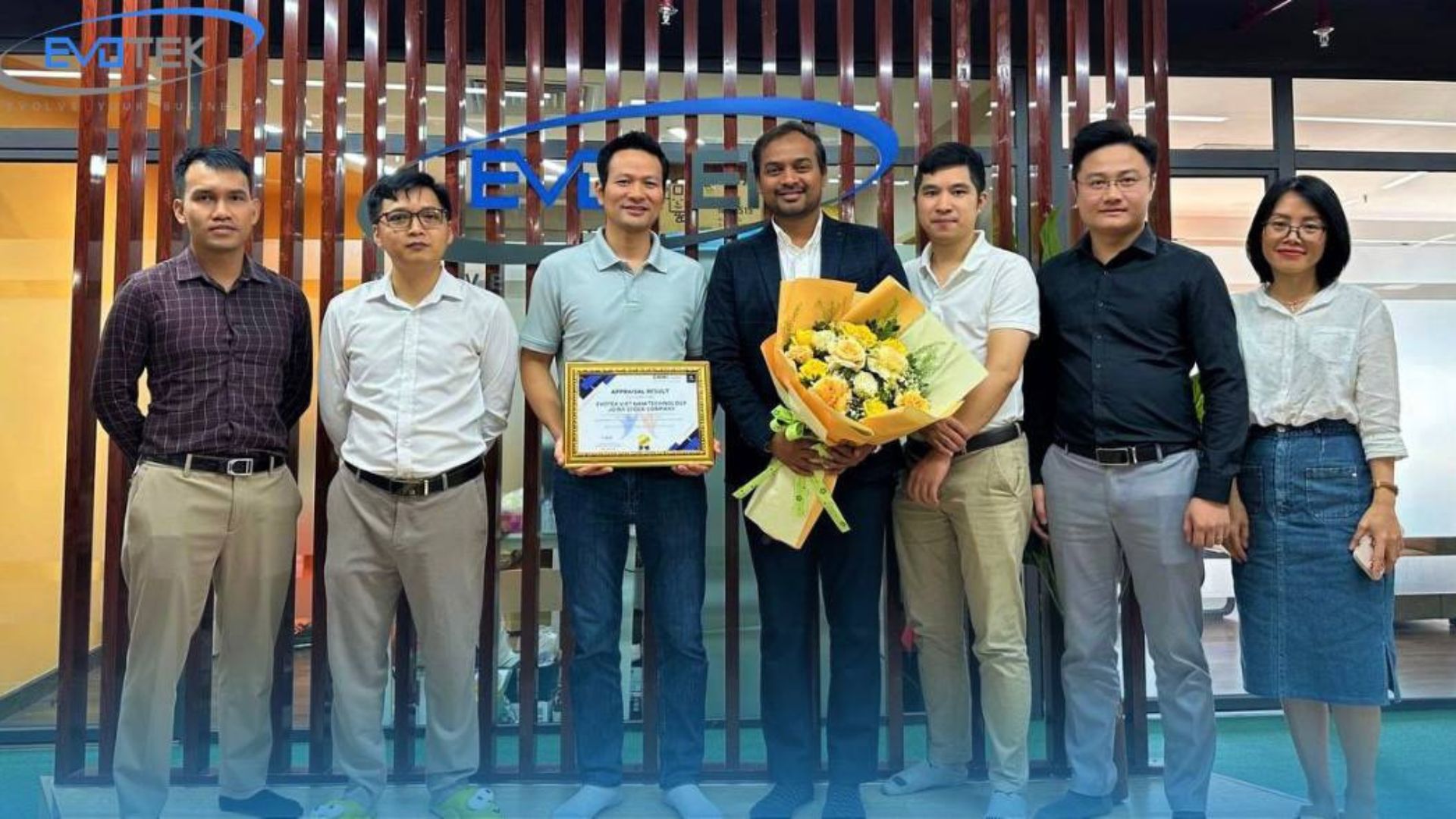
CMMI Level 3 Delivers results
- Deliver high-quality projects within specified timelines and budget constraints for clients
- Effectively mitigate risks and promptly address issues as they arise.
- Ensure a positive customer experience through exceptional quality and service.
With a track record of successfully implementing hundreds of projects, a team of skilled engineers, and adherence to CMMI Level 3 standards, Evotek stands out as the premier choice for enterprise software development projects
